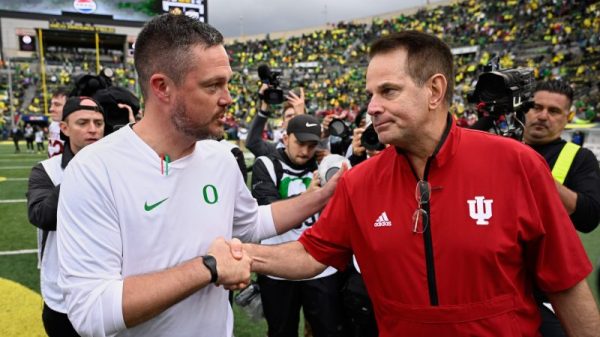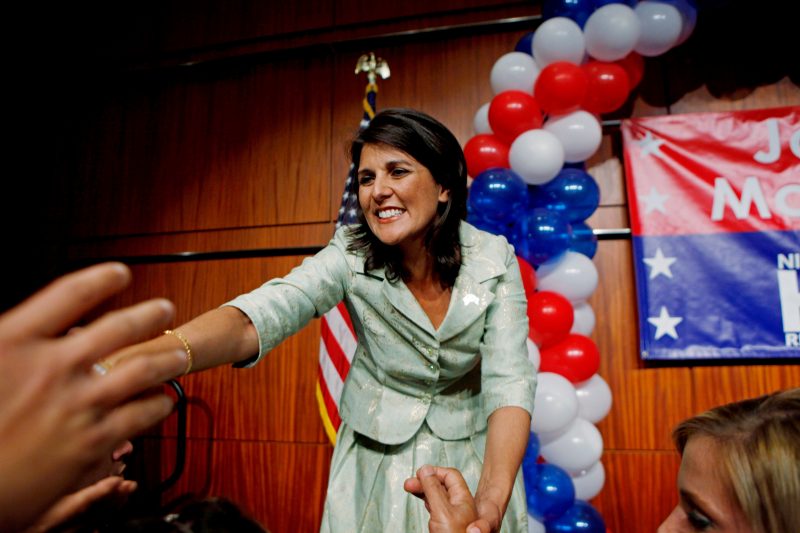COLUMBIA, S.C. — Former congressman J. Gresham Barrett (R-S.C.) still remembers what he calls the “seismic” quake that upended the 2010 South Carolina Republican primary for governor.
His campaign had just gotten polling results that second Wednesday in May, which showed him leading a trio of rivals — two other White Republicans and a little-known Indian American state lawmaker named Nikki Haley, who had been rising in the polls but was still mired in single digits.
Then, that Friday, former vice-presidential candidate Sarah Palin came to town, holding a raucous rally for Haley on the steps of the South Carolina State House in downtown Columbia.
“We felt a tectonic shift, honestly, to the point where we actually went back into the field the next week, because it was that earth-shattering,” Barrett said.
The results were stark: All three men had dropped in internal polling, Barrett said, “and Nikki had gone from single digits to the 20s — and she never came back down.”
The 3½ week stretch in spring 2010 — from when Palin endorsed Haley on May 14 to when Haley bested her three rivals in the state’s Republican gubernatorial primary on June 8 — proved seminal for Haley, who went on to serve as South Carolina’s governor for six years.
During that 26-day period, Haley, then 38, would successfully take on her state’s good ol’ boy network, all while parrying an onslaught of sexist and racist attacks — including being called a “raghead” by a fellow lawmaker and two claims without evidence that she’d had affairs outside of her marriage, which she denied.
The 2010 race was Haley’s coming-of-age moment in politics, catapulting her from relative obscurity in the legislature to a star with national potential. The contest is where she first forged the political instincts that guided her through her governorship, her stint as Donald Trump’s ambassador to the United Nations and now as a presidential candidate.
She emerged with a battle-hardened exterior; a scrappy, never-count-me-out bravado; and a road map to a come-from-behind victory that both allies and critics say she is hoping to recreate in her 2024 bid for White House.
The parallels are striking. Now, as then, Haley — the only woman in the Republican presidential field — is surging in the polls, steadily climbing from her initial perch near the bottom. As she did 13 years ago, Haley has also distinguished herself through strong debate performances and an ability to effectively dismiss racist and sexist attacks. The viciousness of the attacks on her then also heightened a sense of distrust and demand for loyalty that she has carried into 2024.
And she is hoping to vanquish her party’s dominant forces, as she did in South Carolina — this time in the form of Donald Trump, who has a commanding lead in every poll of Republican primary voters.
Haley declined repeated requests for an interview through her campaign.
Of course, defeating Trump and emerging as the Republican presidential nominee is a far more daunting task than winning a race for governor. The Republican Party has shifted, and Haley, 51, has nearly two decades in public life to defend.
Trump also enters the race as a former president, with a viselike grip over a meaningful swath of the Republican Party. And Trump — known for his crude nicknames and history of leaving his rivals abased and sullied — has not yet trained his full focus, or arsenal of insults, on her.
Haley has also blundered into several self-inflicted mishaps just as voters and the media are giving her a closer look. At a recent town hall in New Hampshire, she failed to utter the word “slavery” when asked about the cause of the Civil War. And on Wednesday, again campaigning in New Hampshire, Haley irritated some Iowans when she joked that voters in the Granite State could “correct” the outcome of the caucuses.
Some allies privately worry she may have overlearned some of the lessons of her 2010 gubernatorial bid, which instilled in her a deep wariness of even close allies and a tendency to hold grudges that could hamper her ambitions. But those who have followed her political career since its early days say her run for governor was instructive — not just for Haley, but for those who tried to stand in her way.
“Let me just say lessons learned — don’t underestimate Governor Nikki Haley,” said Barrett, who is supporting her 2024 bid.
When Haley began toying with a gubernatorial bid, almost no one thought she should run — and fewer still thought she would win.
Katon Dawson — a former South Carolina Republican Party chairman, who is now working for her presidential campaign — recalls that he was one of many people who initially tried to persuade Haley to run for state treasurer instead, and at one point even told her he could help her take over for him as the state party chair.
“She looked me square in the face and said, ‘Katon, I’m going to be governor,’” he said. “I said, ‘Okay, Nikki, good luck! I’m pulling for you.’”
Her 2024 bid, he added, is the exact same: “She’s not looking to be anything but the president of the United States.”
Even once Haley announced her gubernatorial campaign, she garnered little attention at first.
Henry McMaster, who was then the state’s attorney general and would eventually succeed Haley as governor, was one of Haley’s Republican opponents. At the time, the McMaster team believed it was a two-man race between him and Barrett, and began gearing up for what Trey Walker, who ran McMaster’s campaign, described as “a sort of binary, Cold War-type operation, that the Hatfields were going to beat the McCoys.”
Haley, Walker added, was “young and talented, but couldn’t raise any money, didn’t have any support, so [we] really didn’t have a whole lot of consideration for her.”
Mark Sanford, the state’s then-governor, had been one of Haley’s allies in the statehouse, and one of the few people who had encouraged her to run to replace him — even penning a list of promises he made to help her. But shortly after she announced her bid, Sanford’s personal and political life imploded after he went missing for several days — only to emerge and announce he was having an extramarital affair with an Argentine woman.
Haley suddenly needed to strike a delicate balance — distancing herself from the South Carolina governor who overnight had become political kryptonite, while still harnessing whatever help Sanford could provide.
In 2010, never fully disavowing Sanford was a sign of her political prowess, allies say. “She’s delicate when she attacks someone on the same side,” said Erick Erickson, a conservative radio host who supported Haley in 2010.
In fact, Haley returned to Sanford with a list of the ways he had said he would help her, complete with a sticky note labeled “promises,” said someone familiar with the meeting, who spoke on the condition of anonymity to share candid details about the interaction. She pressed Sanford for ReformSC, a nonprofit group with ties to him and his political agenda, to use its money to help boost her nascent campaign.
Ultimately, ReformSC bought $400,000 of ads, producing the first pro-Haley commercial of the race and touting her ties to the growing populist tea party movement. The ad helped put her onto the radar of the state’s primary voters.
“I consider that to be the sort of seminal moment where Nikki Haley stepped through a door that she would never walk back through backwards again,” said Walker, who would later go on to work for Haley as the deputy chief of staff in her governor’s office.
Sanford, frustrated with what he viewed as Haley’s lack of gratitude, later apologized to McMaster for the ad, according to someone familiar with the situation, who spoke on the condition of anonymity to share candid details.
But if Haley was slowly rising, it was the hard-fought endorsement of Sarah Palin — then just two years removed from her star turn as a vice-presidential candidate — that lifted her above her primary rivals.
Haley had long courted Palin, who in the 2010 cycle was the self-proclaimed “Mama Grizzly,” bestowing her star power onto lucky grizzly cubs. After initial resistance from her team, Palin agreed after being given internal polling that showed Haley leading the field.
And so, on Friday, May 14, on the steps of the South Carolina State House, Haley welcomed Palin to the state, and Palin told the crowd of roughly 1,000 that while Haley might be an underdog, they shouldn’t count her out.
“She is a fighter and she’s a winner,” Palin said.
The cheering could be heard at the Barrett campaign headquarters just down the street, and the Palin endorsement — coupled with the support of Jenny Sanford, Mark Sanford’s ex-wife — created what one news report dubbed “a rock star sisterhood” that offered Haley a much-needed spotlight.
“It was like an earned media blowtorch,” said Rob Godfrey, who worked on McMaster’s primary campaign against Haley, but later joined her general election campaign and served as deputy chief of staff in the governor’s office. “No one else could break through the news cycle.”
Jenny Sanford said that in 2010 Haley managed to peak at just the right time — a parallel also happening now, with Haley rising in the polls shortly before the Iowa caucuses and New Hampshire primary.
“Campaigns are funny — you have to save your money to spend when people are listening and paying attention, and you really have to straddle that line,” Jenny Sanford said. “Haley learned that skill in that 2010 campaign, for a number of reasons. She ran a great campaign. She really had to tread that line, where you have to keep yourself in the news in a positive way and get your message out while not really spending money, while you raise money.”
Walker, who was watching Haley’s rise from the McMaster campaign, also remembers the importance of that rally.
“She was actually able to transfer political capital from Sarah Palin to Nikki Haley, and give her a stage that she didn’t have before, both literally and figuratively,” Walker said.
He added: “That’s about when the shenanigans all started.”
The first attack came just 10 days after Haley’s rally with Palin, when Will Folks, a conservative political blogger in the state who had previously worked for Haley, alleged that the two had had “an inappropriate physical relationship” — a claim Haley denied.
The second attack came a week after that, when Larry Marchant — a lobbyist who, until that day, had worked for then-Lt. Gov. André Bauer, another one of Haley’s primary rivals — claimed he and Haley had a one-night stand. Haley denied it.
And the final attack came the very next day, when Jake Knotts, then a state senator, called Haley a “raghead” on an internet talk show.
Neither Folks nor Marchant provided proof of their allegations, which Haley repeatedly denied. She even promised to resign the governorship should any irrefutable evidence of an affair arise.
Reached for comment, Folks noted in an email that he now has “a large, happy family — and a thriving, respected media outlet,” and wrote: “I stand by the facts contained in my sworn affidavit, but I don’t have anything to say about the relationship at this time.” Marchant did not respond to requests for comment.
But the sexist charges and racist slur suddenly thrust Haley into the gale-force frenzy of a national media spectacle.
“The Haley campaign couldn’t get 10 people and one TV camera to come out and cover them until Sarah Palin and these outlandish and baseless allegations were made, and it taught her a lot about how to navigate life with new interest from potential supporters, life under the lights of public scrutiny, and life going from fourth-place ‘Nikki Who’ to first-place ‘Nikki Wow’,” Godfrey said.
Politics in South Carolina have long been as dirty as the tea is sweet.
During the heated 2000 Republican presidential primary between Sen. John McCain and Texas Gov. George W. Bush, for instance, a whisper campaign in South Carolina used the daughter McCain and his wife had adopted from Bangladesh years before to falsely claim that McCain had illegitimately fathered a Black child.
The attacks on Haley fit easily into the state’s reputation for dirty tricks.
Folks dribbled out a steady stream of details — including phone records that showed hundreds of calls between the two — but none contained clear evidence of an affair, and Haley’s campaign at the time called the phone log a “ridiculous” interpretation of calls showing their close working relationship.
Haley’s strategy was twofold: her campaign manager, Tim Pearson, would release a statement addressing the latest claim. And then Haley herself would focus on the substance of the governor’s race, but would also take media questions about the allegations at the end of her events.
“Nikki was very forceful in that she was not going to run from this, so she was like, ‘I’m going to handle this,’ and our advice to her was, ‘You can’t prove a negative so don’t get into the details. Just be yourself and you’ll be all right,’ and she was,” Pearson said.
In one 2010 candidate forum, held after the second allegation of a one-night stand had emerged, the moderator opened by asking Haley about the two extramarital affair claims and then pressing her on her message to voters who say, “where there’s a little smoke, there might be some fire.”
A smiling Haley again denied the allegations, said they were simply getting her “more determined than I have ever been, and more fired up,” and then turned her fire on Bauer, whose former staffer was the one leveling the one-night stand claim.
“But Lieutenant Governor, you paid him — he was a paid consultant for you,” Haley said. “You all were fishing the story last night, and you didn’t fire him yesterday. It was only when no one would take it seriously because he is a paid consultant that you decided to fire him today.”
Bauer looked gobsmacked, and stood silent and blinking for four seconds before the moderator moved on. But advisers to her opponents’ campaigns remember seeing then the feisty debate-stage Haley who has now earned plaudits for her performance during the 2024 primary debates.
The attacks — and Haley’s above-the-fray dismissal of them — helped fuel her rise.
“She has always benefited from the fact that there are people, particularly men, who are just so clumsy in their dealings with her and in the things they say about her, that they either intentionally or unintentionally cast themselves as the best foils for her,” Godfrey said. “That started in those days, and it has continued all the way through until now.”
Now, Haley is again facing gendered and racist attacks. Trump has repeatedly called her a “bird brain,” a nickname she’s laughed off, and during one debate, entrepreneur Vivek Ramaswamy, another Republican rival, dismissed both her and Florida Gov. Ron DeSantis as “Dick Cheney in heels.” At an event in Iowa on Saturday, Trump baselessly suggested Haley would be indicted as president “because they’ll say she was having an affair or something.”
On right-wing social media, there have been scattered insinuations that she is not a true Christian or American, and attacks questioning why she uses her middle name rather than her first name, Nimrata — despite her having gone by Nikki since childhood.
“Being a woman and a minority helps and it hurts, and she played it as well as anybody,” said Sen. Lindsey O. Graham (R-S.C.), a Trump supporter.
But the fighting and attacks 13 years ago took a toll on Haley, according to people familiar with her evolution, some of whom spoke on the condition of anonymity to share candid assessments of a sensitive topic.
Both allies and critics say she became far more insular and distrustful. After all, Folks, the first person to accuse her of an affair, had once worked for her, and she viewed the episode as a total betrayal. The anger lingered.
When Haley agreed to endorse Sen. Marco Rubio (R-Fla.) for president in 2016, she had one condition: She refused to be in the same room as one of his top staffers, who had worked for one of her 2010 rivals, according to three people familiar with the demand. Another Republican operative, who worked for a different 2010 rival, said Haley has brought up the dirtiness of that campaign the past two times the two have encountered each other, and made it clear she blames him.
A third Republican, who also worked for a 2010 Haley rival, said that Haley “blamed everybody — she blamed me, she blamed anybody associated with our campaign.”
People who have worked both for and against Haley describe a demand for absolutely loyalty that borders on pettiness, and a distrust of even would-be allies that borders on paranoid, which they attribute to her 2010 race.
“The whole saga made Nikki much more insular,” said one person who knows Haley. “After that, everyone who has ever been on her team has to basically sign a blood oath. When you work with Nikki, you only work with Nikki, and that’s how it’s been ever since.”
However, several of Haley’s top strategists today also work for other clients.
On Tuesday, June 8, 2010, the night of the South Carolina Republican gubernatorial primary, Haley came less than one point from clearing the 50 percent threshold to avoid a runoff. She more than doubled the vote share of Barrett, her next closest competitor.
But Haley was devastated, according to people familiar with the moment and her own recounting in her book.
She simply could not fathom enduring another two weeks of vicious attacks and dirty politics in the runoff. She retreated to the bathroom and had to be coaxed out by her mom, Pearson, and others, she wrote.
“From the very beginning, it was us versus the establishment,” Haley told the crowd, when the chants of her name — “Nikki! Nikki! Nikki!” — finally subsided.
She went on to easily win the runoff, and then the governorship. And she also emerged with a playbook honed during that period forged in the crucible of her home state’s rough-and-tumble politics.
“What’s her superpower? It’s ‘I can do things other people say I can’t,’” Pearson said. “There’s something about the fight that matters to her.”
Others, however, worry that Haley — who has never lost a race — may have overlearned unhelpful lessons from that period. For Haley, one such ally said, the lesson is: “I was right.”
Now, Haley seems to be betting, as she always has, on herself. And the similarities to 2010 are not lost on her.
At the Iowa State Fair in August — clad in a T-shirt blaring the words “Underestimate Me. That’ll Be Fun” — Haley recounted her time as “Nikki Who” at three percent in the polls when she began her 2010 race.
“I’ve been underestimated in everything I’ve ever done, but it’s a blessing,” she said. “Because it makes me scrappy. No one’s going to outwork me in this race. No one’s going to outsmart me in this race.”



























